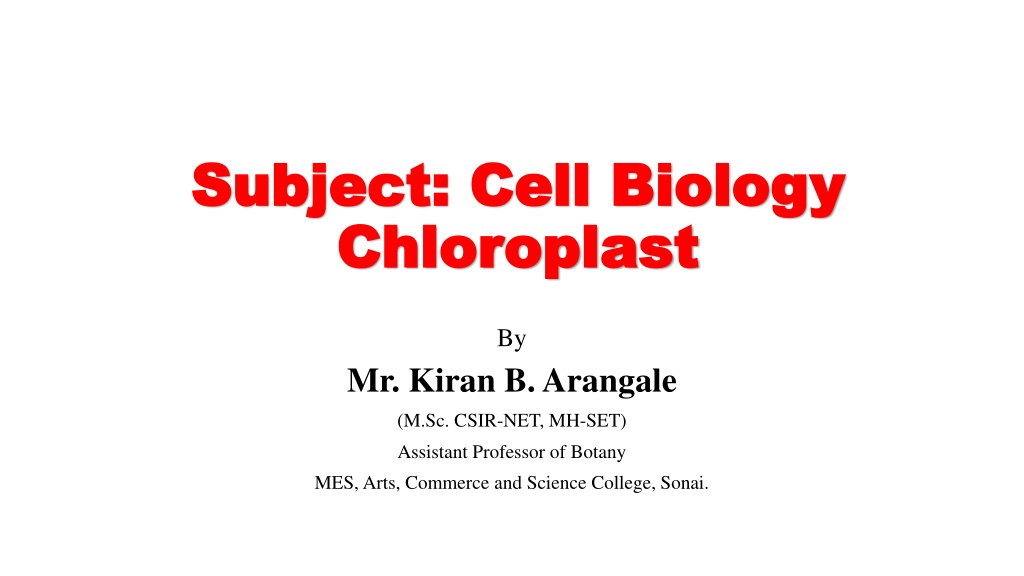Understanding Chloroplast: The Green Powerhouse of Plant Cells
Chloroplasts, key organelles in plant cells, contain chlorophyll for photosynthesis, producing food and oxygen. They are absent in animal cells, housing their own DNA and capable of independent reproduction. The structure includes grana and stroma, each serving vital roles in energy production within plants.
Download Presentation

Please find below an Image/Link to download the presentation.
The content on the website is provided AS IS for your information and personal use only. It may not be sold, licensed, or shared on other websites without obtaining consent from the author. Download presentation by click this link. If you encounter any issues during the download, it is possible that the publisher has removed the file from their server.
E N D
Presentation Transcript
Subject: Cell Biology Subject: Cell Biology Chloroplast Chloroplast By Mr. Kiran B. Arangale (M.Sc. CSIR-NET, MH-SET) Assistant Professor of Botany MES, Arts, Commerce and Science College, Sonai.
Plants form the basis of all life on earth and are known as producers. Plant cells contain structures known as plastids which are absent in animal cells. These plastids are double-membraned cell organelles which play a primary role in the manufacturing and storing of food. There are three types of plastids Chromoplasts- They are the color plastids, found in all flowers, fruits and are mainly responsible for their distinctive colors. Chloroplasts- They are green colored plastids, which comprises green- coloured pigments within the plant cell and are called as the chlorophyll. Leucoplasts- They are colorless plastids and are mainly used for the storage of starch, lipids, and proteins within the plant cell.
Chloroplast Chloroplast Chloroplast is an organelle that contains the photosynthetic pigment chlorophyll that captures sunlight and converts it into useful energy, thereby, releasing oxygen from water.
What is a Chloroplast? What is a Chloroplast? Chloroplasts are found in all green plants and algae. They are the food producers of plants. These are found in the guard cells located in the leaves of the plants. They contain a high concentration of chlorophyll that traps sunlight. This cell organelle is not present in animal cells. Chloroplast has its own DNA and can reproduce independently, from the rest of the cell. They also produce amino acids and lipids required for the production of chloroplast membrane.
Structure of Structure of Chloroplast Chloroplasts are found in all higher plants. It is oval or biconvex, found within the mesophyll of the plant cell. The size of the chloroplast usually varies between 4-6 m in diameter and 1-3 m in thickness. They are double-membrane organelle with the presence of outer, inner and intermembrane space. There are two distinct regions present inside a chloroplast known as the grana and stroma. Chloroplast
Grana are made up of stacks of disc-shaped structures known as thylakoids. The grana of the chloroplast consists of chlorophyll pigments and are the functional units of chloroplasts. Stroma is the homogenous matrix which contains grana and is similar to the cytoplasm in cells in which all the organelles are embedded. Stroma also contains various enzymes, DNA, ribosomes, and other substances. Stroma lamellae function by connecting the stacks of thylakoid sacs.
Membrane Envelope - It comprises inner and outer lipid bilayer membranes. The inner membrane separates the stroma from the intermembrane space. Intermembrane Space- The space between inner and outer membranes. Thylakoid System- The system is suspended in the stroma. It is a collection of membranous sacs called thylakoids. The green coloured pigments called chlorophyll are found in the thylakoid membranes. It is the sight for the process of light-dependent reactions of the photosynthesis process. The thylakoids are arranged in stacks known as grana and each granum contains around 10-20 thylakoids.
Stroma- It is a colourless, alkaline, aqueous, protein-rich fluid present within the inner membrane of the chloroplast present surrounding the grana. Grana- These are the sites of conversion of light energy into chemical energy. Chlorophyll- It is a green photosynthetic pigment that helps in the process of photosynthesis.
Functions of Functions of Chloroplast The most important function of the chloroplast is to synthesize food by the process of photosynthesis. Absorbs light energy and converts it into chemical energy. Chloroplast has a structure called chlorophyll which functions by trapping the solar energy and used for the synthesis of food in all green plants. Produces NADPH and molecular oxygen (O2) by photolysis of water. Produces ATP Adenosine triphosphate by the process of photosynthesis. The carbon dioxide (CO2) obtained from the air is used to generate carbon and sugar during the Calvin Cycle or dark reaction of photosynthesis. Chloroplast
Assignment Assignment 1. Write the Structure of Chloroplast 2. Write the Function of Chloroplast 3. Sketch and labeled diagram of chloroplast 4. Short notes on Photosystem 1 and 2. 5. Short notes of Functions of Thylakoid.
























